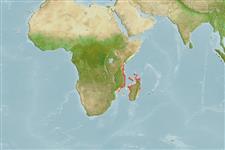Common names from other countries
Environment: milieu / climate zone / depth range / distribution range
Ecologie
; diepteverspreiding 59 - 406 m (Ref. 4), usually 59 - 61 m (Ref. 4). Tropical; 7°N - 27°S, 34°E - 50°E (Ref. 4)
Indo-West Pacific.
Length at first maturity / Size / Gewicht / Leeftijd
Maturity: Lm ? range ? - ? cm Max length : 11.8 cm TL mannelijk/geslacht niet bekend; (Ref. 122081); common length : 9.5 cm BL mannelijk/geslacht niet bekend; (Ref. 4)
It has lengths of 9.5 cm, total body length; 3 cm, carapace length (Ref. 4). Occurs at a depth of 406 m but also from 59 to 61 m with muddy substrate (Ref. 4).
Life cycle and mating behavior
Geslachtsrijpheid | Voortplanting | Kuitschieten | Eieren | Fecundity | Larven
Members of the order Decapoda are mostly gonochoric. Mating behavior: Precopulatory courtship ritual is common (through olfactory and tactile cues); usually indirect sperm transfer.
Holthuis, L.B. 1991. (Ref. 4)
Status op de Rode Lijst van het IUCN (Ref. 130435)
Status bij CITES (Ref. 108899)
Not Evaluated
Not Evaluated
Gebruik door de mens
Visserij: van geen belang
| FishSource |
Tools
Meer informatie
Leeftijd/GrootteGroeiLengte-gewicht parametersLengte-lengte parametersMorfologieLarvenAbundantie
Internet-bronnen
Estimates based on models
Preferred temperature
(Ref.
115969): 10.8 - 25.1, mean 15.6 (based on 46 cells).
